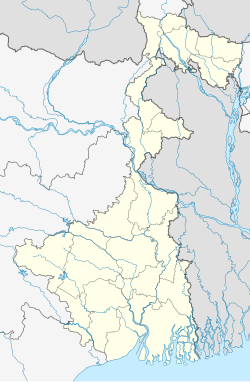Hatgobindapur is a village in Burdwan II CD block in Bardhaman Sadar North subdivision of Purba Bardhaman district in the state of West Bengal, India.
Hatgobindapur | |
|---|---|
Village | |
| Coordinates: 23°15′45″N 87°58′42″E / 23.2625°N 87.9784°E | |
| Country | |
| State | West Bengal |
| District | Purba Bardhaman |
| Population (2011) | |
| • Total | 5,823 |
| Languages | |
| • Official | Bengali, English |
| Time zone | UTC+5:30 (IST) |
| PIN | 713407 (Hatgobindapur) |
| Telephone/STD code | 0342 |
| Lok Sabha constituency | Bardhaman-Durgapur |
| Vidhan Sabha constituency | Bardhaman Uttar |
| Website | purbabardhaman |
Geography
edit5miles
M: municipal city/ town, CT: census town, R: rural/ urban centre, H: historical site, W: river project, C: craft centre
Owing to space constraints in the small map, the actual locations in a larger map may vary slightly
Location
editHatgobindapur is located at 23°15′45″N 87°58′42″E / 23.2625°N 87.9784°E.
Urbanisation
edit73.58% of the population of Bardhaman Sadar North subdivision live in the rural areas. Only 26.42% of the population live in the urban areas, and that is the highest proportion of urban population amongst the four subdivisions in Purba Bardhaman district.[1] The map alongside presents some of the notable locations in the subdivision. All places marked in the map are linked in the larger full screen map.
Demographics
editAs per the 2011 Census of India Hatgobindapur had a total population of 5,823, of which 2,933 (50%) were males and 2,890 (50%) were females. Population below 6 years was 533. The total number of literates in Hatgobindapur was 3,989 (75.41% of the population over 6 years).[2]
Transport
editThe Bardhaman-Kalna Road passes through Hatgobindapur.[3]
Education
editDr. Bhupendra Nath Dutta Smriti Mahavidyalaya was established at Hatgobindapur in 1996. It offers honours courses in Bengali, Sanskrit, English, history, political science, philosophy, geography, accountancy, mathematics, chemistry, botany, zoology and nutrition.[4][5]
Culture
editPanchanan’s fair is organised at Hatgobindapur in the Bengali month of Ashadha. The village has temples dedicated to Manasa, Sridhara and Durga.[6]
David J. McCutchion mentions the Sridhara temple (18’8” façade) as a standard 17th century atchala temple with porch on triple archway and the Shiva temple (beside the main road) as a standard pancharatna temple with bridged rekha turrets and single entrance. The latter has predominantly vegetal/ floral design.[7]
Healthcare
editThere is a primary health centre at Kashiara, PO Hatgobindapur (with 4 beds).[8]
References
edit- ^ "District Statistical Handbook 2014 Bardhaman". Table 2.2. Department of Statistics and Programme Implementation, Government of West Bengal. Archived from the original on 21 January 2019. Retrieved 25 January 2019.
- ^ "2011 Census – Primary Census Abstract Data Tables". West Bengal – District-wise. Registrar General and Census Commissioner, India. Retrieved 18 March 2017.
- ^ Google maps – focus on the coordinates for Hatgobindapur
- ^ "Dr. Bhupendra Nath Dutta Smriti Mahavidyalaya". DBNDSM. Archived from the original on 7 June 2017. Retrieved 2 March 2017.
- ^ "Dr. Bhupendra Nath Dutta Smriti Mahavidyalaya". College Admission. Retrieved 2 March 2017.
- ^ Chattopadhyay, Akkori, Bardhaman Jelar Itihas O Lok Sanskriti (History and Folk lore of Bardhaman District.), (in Bengali), Vol II, pages 83-88, page 592. Radical Impression. ISBN 81-85459-36-3
- ^ McCutchion, David J., Late Mediaeval Temples of Bengal, first published 1972, reprinted 2017, pages 33, 48. The Asiatic Society, Kolkata, ISBN 978-93-81574-65-2
- ^ "Health & Family Welfare Department". Health Statistics. Government of West Bengal. Retrieved 19 January 2019.

